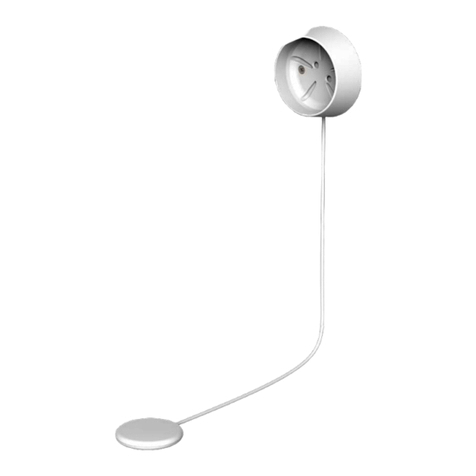
Page 9 of 24 P/N 595370-01 Rev B 07/19
WARNING
KEEP THE ANTENNAS OF HAND-HELD RADIOS
AT LEAST SIX (6) INCHES AWAY FROM THE
CONTROL CONSOLE AND THE SENSOR
MODULE OF THE DISTRESS ALARM WHEN
TRANSMITTING. CLOSE PROXIMITY OF RADIO
EQUIPMENT TO THE DISTRESS ALARM DURING
RADIO TRANSMISSION MAY CAUSE THE UNIT
TO MALFUNCTION. FAILURE TO RECOGNIZE A
MALFUNCTION OF THE DISTRESS ALARM AND
TAKE THE PROPER CORRECTIVE ACTION MAY
RESULT IN A NON-WORKING DISTRESS ALARM,
WHICH WILL NOT SOUND IF THE USER STOPS
MOVING AND MAY LEAD TO SERIOUS INJURY
OR DEATH.
WARNING
BE AWARE OF THE POTENTIAL EFFECT
OF RADIO TRANSMISSIONS FROM BASE
STATION OR TRUCK MOUNT RADIOS WHEN
USING AN SCBA WITH THE DISTRESS ALARM.
CLOSE PROXIMITY OF RADIO EQUIPMENT
TO THE DISTRESS ALARM DURING RADIO
TRANSMISSION MAY CAUSE THE UNIT TO
MALFUNCTION. FAILURE TO RECOGNIZE A
MALFUNCTION OF THE DISTRESS ALARM AND
TAKE THE PROPER CORRECTIVE ACTION MAY
RESULT IN A NON-WORKING DISTRESS ALARM,
WHICH WILL NOT SOUND IF THE USER STOPS
MOVING AND MAY LEAD TO SERIOUS INJURY
OR DEATH.
DETECTING AND AVOIDING RADIO FREQUENCY
INTERFERENCE
When any electronic device is adversely affected by radio waves, radio
frequency interference (RFI) is said to have occurred. All electronic
devices like the distress alarm may be subject to the effects of RFI. Radio
transmissions from the antennas of radios including those used by re
ghters, police and other public safety related personnel may produce
RFI in the distress alarm. RFI may occur while the radio is transmitting if
the SCBA equipped with the distress alarm is in close proximity to a base
station or high-powered vehicle mounted radio, or if the antenna of a
personal portable hand held radio is touching or within six (6) inches of the
Control Console or Sensor Module of the distress alarm. See FIGURE 5.
Be aware of the symptoms of RFI. A distress alarm affected by RFI may
temporarily give false indications, such as the sudden sounding of the
loud continuous three-tone chirp of the full alarm. In some instances the
lights on the control console may ash without sounding the alarm. In rare
circumstances, a sounding alarm may stop.
If the distress alarm exhibits any of the symptoms of RFI, identify the
source of the RFI and do the following:
• If the symptoms of RFI occur when standing near a base station
transmitting antenna or a truck mounted radio antenna, move away
from the antenna until the symptoms stop.
• If the symptoms of RFI occur while transmitting on a hand-held radio,
move the radio away from the distress alarmT .
CHECK THE CONTROL CONSOLE AND BE CERTAIN THE GREEN
LIGHT IS FLASHING NORMALLY WHEN THE INTERFERENCE STOPS,
REGARDLESS OF THE SOURCE.
In normal usage with the air cylinder open, the distress alarm will typically
resume normal operation after experiencing RFI.
If the distress alarm is affected by RFI when the SCBA air supply is turned
off or the cylinder is empty, the distress alarm could be turned off during
use. If this occurs, depress the RED Manual Alarm Button to activate the
alarm.
IF THE SYMPTOMS OF RFI OCCUR, CHECK THE DISTRESS ALARM
TO VERIFY THAT IT IS FUNCTIONING PROPERLY. IF THE GREEN
LIGHT ON THE CONTROL CONSOLE DOES NOT RESUME FLASHING
IN THE NORMAL MANNER AFTER EXPERIENCING THE SYMPTOMS
OF RFI, OR IF THE UNIT CONTINUES TO MALFUNCTION IN ANY
OTHER WAY, PROCEED TO A SAFE AREA, REMOVE THE SCBA FROM
SERVICE AND TAG IT FOR REPAIR BY AUTHORIZED PERSONNEL.
Minimize or eliminate the effects of RFI by protecting the distress alarm
with the following steps:
– Maintain a safe distance from a base station transmitting antenna or a
truck mounted radio antenna.
– Keep the antennas of hand held radios at least six (6) inches away from
the Control Console or the Sensor Module. See FIGURE 5.
If the HHR experiences RFI, it may be necessary to remove it from service.
In a known safe, non-hazardous area, remove and reinstall the batteries
to reset the unit (see the BATTERY REPLACEMENT section of the user
instructions provided with your Locator System equipment). Then inspect
and return the HHR to service.





























